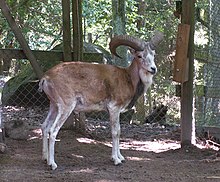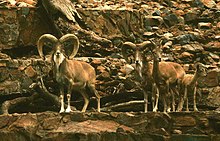Urial
| Urial | |
|---|---|

| |
| Bukhara Urial (Ovis vignei bochariensis) at Nordens Ark, Sweden | |
Conservation status
| |
| Scientific classification | |
| Kingdom: | Animalia |
| Phylum: | Chordata |
| Class: | Mammalia |
| Order: | Artiodactyla |
| Family: | Bovidae |
| Subfamily: | Caprinae |
| Genus: | Ovis |
| Species: | O. vignei
|
| Binomial name | |
| Ovis vignei (Blyth, 1841)[2]
| |
| Synonyms | |
|
Ovis orientalis vignei | |
The urial (Ovis vignei), also known as the arkars or shapo, is a wild sheep native to Central and South Asia. It is listed as Vulnerable on the IUCN Red List.[1]
Characteristics[]

Urial males have large horns, curling outwards from the top of the head turning in to end somewhere behind the head; females have shorter, compressed horns. The horns of the males are up to 100 cm (39 in) long. The shoulder height of an adult male urial is between 80 and 90 cm (31 and 35 in).[citation needed]
Distribution and habitat[]
The urial is native to montane areas in the Pamir Mountains, Hindu Kush and Himalayas up to an elevation of 4,500 m (14,800 ft); it is distributed from northeastern Iran, Afghanistan, Turkmenistan, Tajikistan, Uzbekistan and southwestern Kazakhstan to northern Pakistan and Ladakh in northwestern India. It prefers grassland, open woodland and gentle slopes, but also inhabits cold arid zones with little vegetation.[1]
Behaviour and ecology[]
The mating season begins in September. Rams select four or five ewes, which give birth to a lamb after a gestation of five months.[citation needed]
Taxonomy[]
- Ovis vignei was the scientific name proposed by Edward Blyth in 1841 for wild sheep in the Sulaiman Mountains.[2]
References[]
- ^ Jump up to: a b c Michel, S. & Ghoddousi, A. (2020). "Ovis vignei (errata version published in 2021)". IUCN Red List of Threatened Species. 2020: e.T54940655A195296049. Retrieved 10 April 2021.CS1 maint: multiple names: authors list (link)
- ^ Jump up to: a b Blyth, E. (1841). "An Amended List of the Species of the Genus Ovis". The Annals and Magazine of Natural History; Zoology, Botany, and Geology. 7 (44): 248–261.
- Nowak R. M.: Walker's Mammals of the World, Sixth Edition. The Johns Hopkins University Press, Baltimore, London, 1999.
- Namgail, T., van Wieren, S.E., Mishra, C. & Prins, H.H.T. (2010). Multi-spatial co-distribution of the endangered Ladakh urial and blue sheep in the arid Trans-Himalayan Mountains. Journal of Arid Environments, 74:1162-1169.
- Lingen, H.: Großes Lexikon der Tiere. Lingen Verlag, Köln.
- Prater, S. H.: The Book of Indian Animals, Oxford University Press, 1971.
- Menon, V.: A Field Guide to Indian Mammals, Dorling Kindersley, India, 2003
- CITES Instruktion für den grenztierärztlichen Dienst
- Proposal about subspecies of Urial
- Yahya M. Musakhel et al. 2006: Identification of Biodiversity Hot Spots in Musakhel District balochistan Pakistan.
External links[]
- IUCN Red List vulnerable species
- Ovis
- Mammals of Afghanistan
- Mammals of Pakistan
- Fauna of Iran
- Fauna of Ladakh
- Fauna of India
- Mammals of Central Asia
- Mammals described in 1841
- Subspecies
- Taxa named by Edward Blyth
